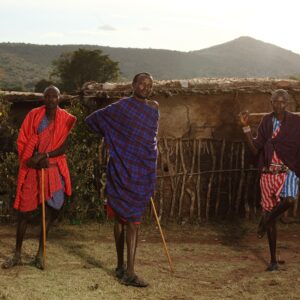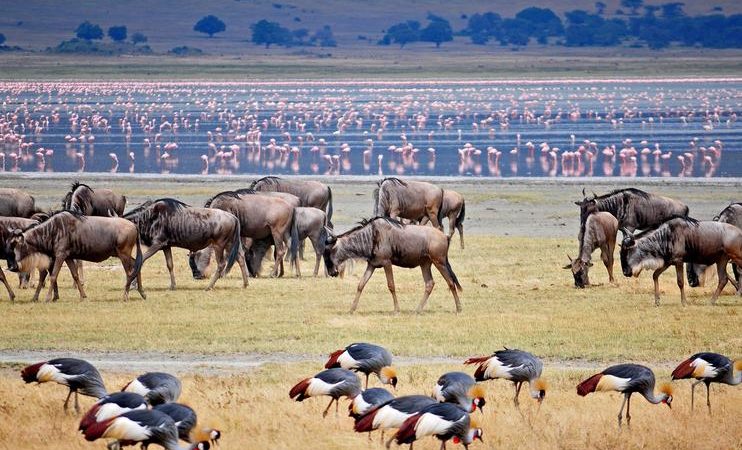10 Wonderful Wildlife In Tanzania To Spot On Your Safari!
This detailed article covers the animals you’ll likely see on a Tanzanian safari, incorporating all the specific points you requested, with a focus on their behavior, where to find them, and what makes each sighting special. Tanzania, a jewel in the crown of East African safari destinations, promises an unparalleled wildlife spectacle. From the vast, iconic plains of the Serengeti to the unique caldera of Ngorongoro, the baobab-studded landscapes of Tarangire, and the groundwater forests of Lake Manyara, this incredible nation offers a diversity of habitats that translates into an astonishing array of animal encounters. A safari here isn’t just a trip; it’s an immersive journey into one of the planet’s last great wildernesses, where the rhythm of nature dictates every breathtaking moment.
As you embark on your Tanzanian adventure, perhaps from the bustling safari hub of Arusha, camera ready and heart pounding, you’ll discover a world teeming with life. Here’s a comprehensive look at the magnificent animals you can expect to encounter, and where your best chances are to spot them. The Apex Predators & The Majestic Giants: Icons of the African Bush. Check this: Wild Animals You Must See on African Safari.
1. Lions (Simba): The Undisputed King
The roar of a lion echoing across the savanna is arguably the most iconic sound of Africa. Tanzania boasts the largest lion population on the continent, making sightings almost a certainty and often frequent. These magnificent creatures are highly social, living in prides that can range from a few individuals to over a dozen.
✓Where to find them. The Serengeti National Park is legendary for its vast lion prides, often found lounging on rocky outcrops (kopjes) or stalking prey across the open plains of areas like the Seronera Valley. The Ngorongoro Crater also offers remarkably high densities of lions due to its confined, prey-rich environment, making them relatively easy to spot. Tarangire National Park is also excellent for lion viewing, sometimes offering the rare spectacle of tree-climbing lions.
✓What to expect. You’ll likely see them in prides, ranging from a few individuals to large family units. Lions are often quite relaxed around safari vehicles, offering fantastic photographic opportunities. Keep an eye out for playful cubs, hunting attempts (especially at dawn or dusk when they are most active), and the awe-inspiring sight of a male’s impressive mane surveying his territory.
2. Elephants (Tembo): The Gentle, Intelligent Giants
The largest land animals on Earth, African elephants are creatures of profound intelligence, complex social structures, and immense presence. Watching a herd move gracefully through the landscape, feeding, bathing, or interacting with each other, is deeply moving. ✓Where to find them. Tarangire National Park is world-renowned for its enormous elephant herds, especially during the dry season (June-October) when thousands congregate around the life-giving Tarangire River. They are also abundant in the Serengeti and the Ngorongoro Crater. ✓What to expect. You’ll witness herds of all sizes, from tiny, wobbly calves playfully wrestling to wise old matriarchs leading their families. Their intricate social interactions, feeding habits (pulling up grass or stripping bark from trees), and dusting or bathing rituals are endlessly captivating.
3. Giraffes (Twiga): The Towering Elegance
The national animal of Tanzania, the giraffe, is instantly recognizable with its impossibly long neck, distinctive coat patterns, and graceful, almost slow-motion gait. They add a unique vertical dimension to the flat savanna landscapes. ✓Where to find them. Giraffes are common and widespread across all major Tanzanian safari parks, including the Serengeti, Tarangire, Ngorongoro, and Lake Manyara. ✓What to expect. You’ll see them elegantly browse on the tops of acacia trees, using their long tongues to strip leaves. Witnessing them awkwardly splay their long legs to reach water to drink, or engage in “necking” (a form of fighting among males) is always a delight.
4. Zebras (Pundamilia): Nature’s Striped Masterpiece
The iconic black and white stripes of the zebra create a mesmerizing pattern across the plains, especially when seen in large herds. They are an integral part of the Great Migration and are often found grazing alongside wildebeest. ✓Where to find them. Zebras are incredibly abundant in the Serengeti and Ngorongoro Crater, particularly as part of the Great Migration herds. They are also frequently seen in Tarangire and Lake Manyara. ✓What to expect. Their striking appearance, the sheer numbers in herds, and their role as companions to wildebeest are captivating. You’ll observe them grazing, grooming each other, and often forming tight groups as a defense against predators.
5. Rhinoceroses (Faru): The Endangered Ancients
Both Black and White Rhinos are critically endangered, making every sighting a poignant reminder of ongoing conservation efforts. Tanzania is home to the Black Rhino, which is rarer and more aggressive than its White counterpart. ✓Where to find them. The Ngorongoro Crater offers arguably the most reliable sightings of the Black Rhino in Tanzania, thanks to intense conservation efforts within the caldera’s relatively confined space. Small, scattered populations also exist in the Serengeti and Nyerere National Park (formerly Selous Game Reserve) in Southern Tanzania. ✓What to expect. Rhinos are heavily guarded in most areas due to poaching threats. Your guide will likely know their general locations, but they are often solitary and may be Browse in dense bush. Seeing one is a powerful and humbling experience.
6. Cheetahs (Duma): The Speed Demons of the Plains
The fastest land animal, the cheetah, is a marvel of evolutionary design, built for incredible speed and agility. They prefer open grasslands for hunting, relying on their explosive sprints to catch prey. ✓Where to find them. The vast, open plains of the Serengeti, especially in the central Seronera Valley and eastern areas, offer excellent opportunities for spotting cheetahs. They are also present in the Ngorongoro Crater and sometimes in Tarangire. ✓What to expect. Often seen perched on a termite mound or a low branch, scanning the plains for prey. Witnessing a high-speed chase, though rare, is an unforgettable adrenaline rush. Their slender build and distinctive tear marks are unmistakable.
7. Hippos (Kiboko): The River’s Enigmatic Residents
Hippos are semi-aquatic giants that spend most of their day submerged in water to protect their sensitive skin from the sun. They are surprisingly agile and aggressive on land, especially when protecting their territory or young. ✓Where to find them. Any permanent water source in the parks, most notably the Hippo Pool in the Serengeti’s Seronera Valley, and the lakes in Lake Manyara and the Ngorongoro Crater. ✓What to expect. You’ll see clusters of hippos, often packed closely together, with only their eyes, ears, and nostrils visible above the water. Listen for their distinctive grunts and snorts, which echo across the water. At night, they emerge from the water to graze.
8. Wildebeests (Nyumbu): The Driven Nomads of the Great Migration
While “wildebeest” encompasses a species, they are a highlight in their millions, driving the planet’s largest overland migration. Their constant movement in search of fresh grazing and water defines a significant part of the Tanzanian safari experience. ✓Where to find them. The Serengeti National Park is the primary stage for this annual drama. Their location within the park varies throughout the year:
December-March: Southern Serengeti (Ndutu region), calving season. April-May: Western Corridor, heading north. June-July: Western Corridor, Grumeti River crossings. August-October: Northern Serengeti (Mara River crossings, often into Kenya). November: Moving south from Kenya back into the northern/central Serengeti. ✓What to expect. Massive, seemingly endless columns of animals, often spread across the plains as far as the eye can see. Dramatic river crossings (Mara or Grumeti) are the pinnacle for many, showcasing raw survival and intense predator-prey dynamics.
9. Buffaloes (Nyati): The Formidable Herds
Often underestimated, the Cape buffalo is one of Africa’s most formidable animals, known for its sheer strength, impressive horns, and sometimes unpredictable temperament. They are considered one of the “Big Five” for a reason. ✓Where to find them. Buffalos are incredibly widespread and can be seen in large herds across virtually all Tanzanian national parks, including the Serengeti, Ngorongoro, Tarangire, and Lake Manyara. ✓What to expect. You’ll likely see vast herds grazing in the open grasslands, often accompanied by oxpecker birds cleaning parasites from their backs. Solitary, older males, known as “dagga boys,” are also common, often found wallowing in mud.
10. Leopards (Chui): The Elusive Master of Stealth
More elusive and solitary than the lion, the leopard is a master of camouflage and stealth. Spotting one, often draped elegantly over a tree branch or moving silently through tall grass, is a rare and highly prized sighting. ✓Where to find them. The Serengeti, particularly the central Seronera Valley, is considered one of the best places in Africa to spot leopards, often found draped over tree branches. Nyerere National Park (Selous) also has a healthy population. In Lake Manyara National Park, they are famous for their unusual habit of climbing trees, though sightings remain challenging everywhere. ✓What to expect. Your guide will often scan trees for their distinctive spotted coat or look for signs of their presence, like kills hoisted high into branches. Their beauty, grace, and incredible stealth make a leopard sighting feel like a true privilege.
11. Hyenas (Fisi): The Misunderstood Architects of the Ecosystem
Often unfairly maligned, spotted hyenas are incredibly intelligent and social animals. They are formidable predators in their own right, not just scavengers, and play a crucial role in the ecosystem. Their eerie, almost human-like calls at night are a quintessential sound of the African bush. ✓Where to find them. Very common in the Serengeti and Ngorongoro Crater, where their distinctive calls are a familiar sound at dusk and dawn. ✓What to expect. Often seen in clans around kills, or moving purposefully across the plains. Their complex social structure and impressive jaws are fascinating to observe.
12. Crocodiles (Mamba): The Ancient Apex Predator of the Waterways
The Nile crocodile, a formidable and ancient reptile, is an apex predator of Africa’s rivers and lakes. Their patience and ambush tactics are legendary. ✓Where to find them. Any significant river or permanent lake in the parks, most notably the Mara River in the Serengeti during the migration (for dramatic crossings), and the Grumeti River. Also present in Lake Manyara and Nyerere National Park. ✓What to expect. You’ll often see them lurking silently in the water, with only their eyes and nostrils visible, or basking on sunny sandbanks. Witnessing a crocodile ambush a crossing wildebeest is a stark, powerful reminder of the raw power of nature.
13. Monkeys and Baboons (Kima & Nyani): The Primate Playwrights
Africa’s primates are endlessly entertaining. ✓Baboons. Highly social and intelligent primates, often seen in large troops. They are opportunistic and can be quite bold. ✓Where to find them. Common in most parks, particularly visible in Lake Manyara where they often roam through the groundwater forest, and along roadsides in Tarangire and the Ngorongoro Conservation Area. ✓What to expect. Observe their complex social dynamics, grooming rituals, and playful antics, as well as their foraging behaviors.
✓Monkeys. Various species exist. Vervet Monkeys are common, smaller, and agile, often seen near camps. Blue Monkeys and Red-tailed Monkeys are more common in forested areas. ✓Where to find them. Widespread. Vervet monkeys are found everywhere. Blue and Red-tailed monkeys are more prevalent in Lake Manyara National Park and forested parts of the Ngorongoro Highlands. ✓What to expect. Their curious nature and acrobatic movements through trees are always engaging.
14. Antelopes: The Graceful Diversity of the Plains
Tanzania is home to a staggering diversity of antelope species, each adapted to its specific niche within the ecosystem. They are a constant presence and a vital food source for predators. Impala (Swala pala). The most common and graceful antelope, easily recognized by their distinctive M-shaped marking on their rump and their impressive leaping ability. Found everywhere. Topi. A strikingly marked, reddish-brown antelope with a slightly hunched appearance, often seen standing on termite mounds. Abundant in the Serengeti and Tarangire.
Eland (Pofu). The largest antelope species, surprisingly agile and powerful despite their size. Found widely, especially in the Serengeti and Tarangire. Kudu. Magnificent spiral-horned antelopes (males), often shy and found in denser bush or woodland areas. Present in Tarangire, Ruaha, and Nyerere National Park. Waterbuck. Recognizable by their shaggy coats and a prominent white ring on their rump. Found near water sources in all parks.
Hartebeest (Kongoni). A peculiar-looking antelope with a long, narrow face and oddly shaped horns. Common in the Serengeti and Tarangire. Dik-dik. Tiny, adorable antelopes, usually seen in pairs, browse in dense bush. Widespread in most parks. Grant’s Gazelle and Thomson’s Gazelle. The most numerous gazelle species, often seen grazing in open plains. Abundant in the Serengeti and Ngorongoro Crater.
15. Warthogs (Ngiri): The Comical Bushpigs
With their distinctive tusks, facial warts, and comical “tail-up” running style, warthogs are a common and amusing sight on any Tanzanian safari. Where to find them: Abundant in all Tanzanian safari parks, especially in open grasslands and near water. What to expect: Often seen kneeling on their front legs to graze, digging for roots with their snouts, or trotting in a line with their piglets, tails held high like antennae.
16. Birds: The Feathered Jewels of Africa
Even if you’re not a dedicated birder, Tanzania’s avian life is incredibly diverse and beautiful, adding another layer of wonder to your safari experience. With over 1,100 species recorded, the variety is astonishing. Where to find them: Everywhere! Lake Manyara National Park is particularly famous for its vast flocks of pink flamingos, pelicans, and other waterbirds. Tarangire is also excellent for birding, with its diverse habitats. The Serengeti and Ngorongoro also host an incredible variety, from large raptors to colorful smaller species.
What to expect: Keep an eye out for:
- Ostriches. The largest living bird, common in the plains.
- Kori Bustard. The heaviest flying bird.
- Secretary Birds. Distinctive long-legged raptors that hunt on the ground.
- Vultures and Eagles. Circling majestically in the sky, often indicating a kill.
- Lilac-breasted Rollers, Superb Starlings, Yellow-collared Lovebirds: Bursting with vibrant colors.
- Kingfishers, Herons, Storks: Abundant near water sources.
Beyond the Expected: Unique Encounters
While the list above covers the most prominent and frequently sighted animals, remember that every safari holds the potential for unexpected delights. Be open to appreciating the smaller creatures, the intricate ecosystems, and the rare, fleeting moments:
African Wild Dogs. While very rare, these highly endangered and intelligent pack hunters are a thrilling sighting, mainly in Southern Tanzania’s Nyerere National Park and Ruaha. Pangolins. Almost impossible to see, these nocturnal, scaly ant-eaters are one of the most trafficked animals globally. A sighting is a true lottery win. Pygmy Mongoose, Bat-eared Foxes, Civets, Genets: Smaller, often nocturnal, but fascinating mammals that skilled guides might spot.
The top most commonly seen animals and where to spot them on your Tanzania Safari. On a Tanzania safari, you’re likely to spot a variety of animals, including the Big Five (lion, leopard, rhino, elephant, and buffalo), wildebeest, zebras, and cheetahs most common animals in Tanzania. The Serengeti National Park and Ngorongoro Crater are excellent locations for spotting these and other wildlife.
A Guide to Identifying the Most Commonly Seen Animals on a Safari in Tanzania. Discover Tanzania’s iconic wildlife with this concise safari guide. Learn to identify the most commonly seen animals, including the majestic African elephant, stealthy leopard, powerful lion, towering giraffe, and swift cheetah. Spot zebras and wildebeest during their great migration, and observe hippos, crocodiles, and countless bird species in their natural habitats. This guide offers essential tips and vivid descriptions to enhance your safari experience, helping you recognize and appreciate the rich biodiversity that makes Tanzania a top wildlife destination.
Your Safari Experience: What to Expect
No two safaris are identical, and wildlife sightings are never guaranteed. However, highly skilled local guides in Tanzania have an incredible ability to track and spot animals.
- Seasonality. The animals you see, and their behavior, can vary with the seasons. The dry season (June-October) typically concentrates animals around water sources, making them easier to spot. The wet season (November-May) brings lush landscapes and newborn animals, but dense vegetation can make spotting harder.
- Patience and Observation. A successful safari requires patience. Sometimes the best sightings come after long waits. Embrace the quiet moments; they are just as much a part of the experience.
- Respect the Wild. Always remember that you are a guest in their home. Follow your guide’s instructions, maintain a respectful distance, and never interfere with the animals or their environment.
A safari in Tanzania is an unforgettable journey into the heart of Africa’s untamed beauty. The sheer abundance and diversity of wildlife will leave you in awe, forging memories that will last a lifetime. Prepare to be captivated by the rhythm of the wild and the incredible creatures that call this magical land home.








